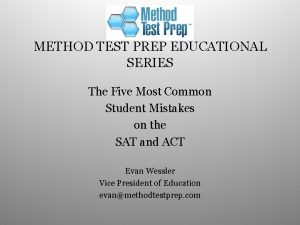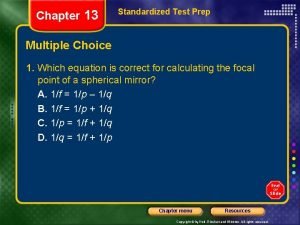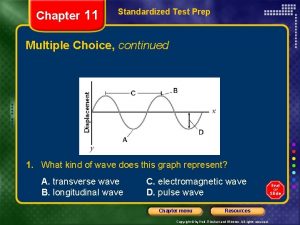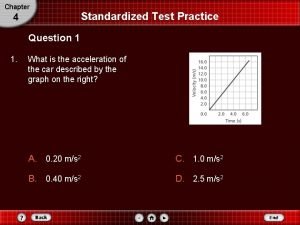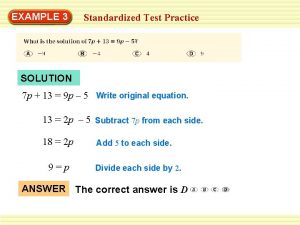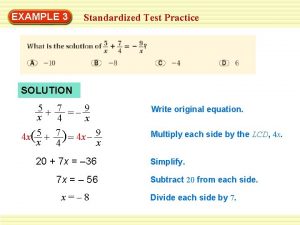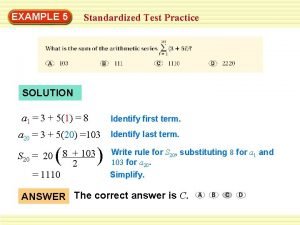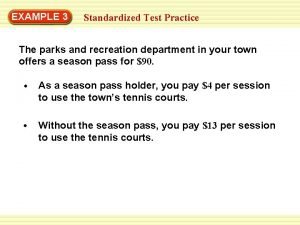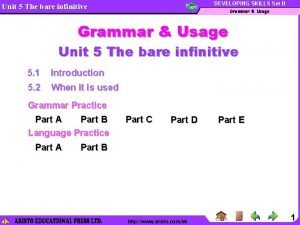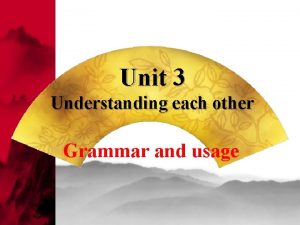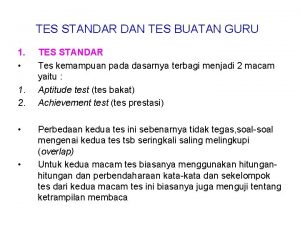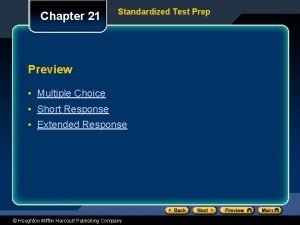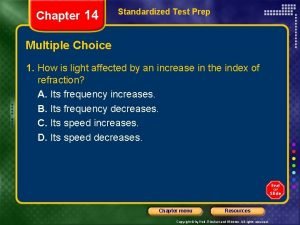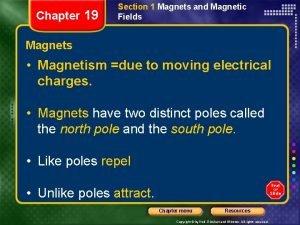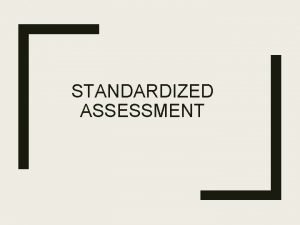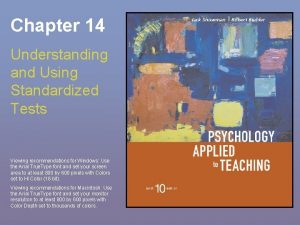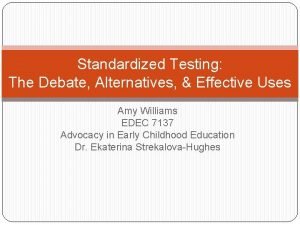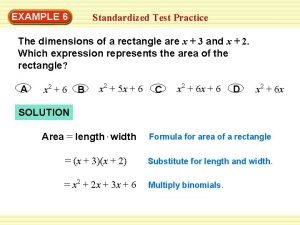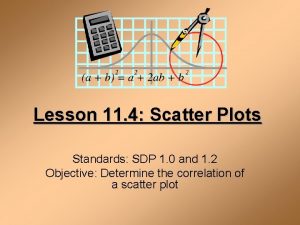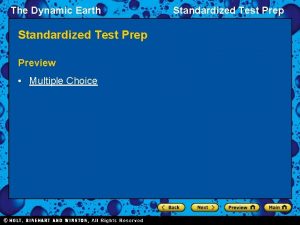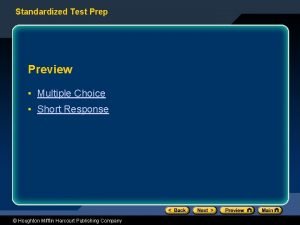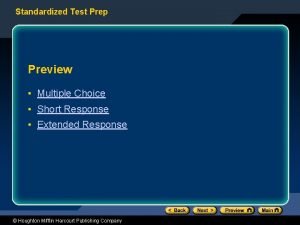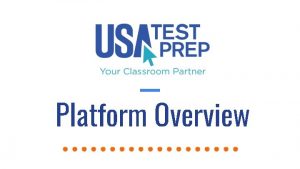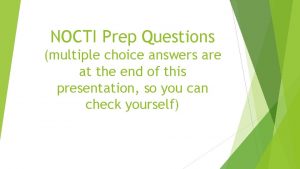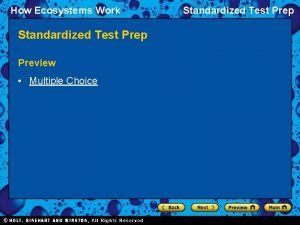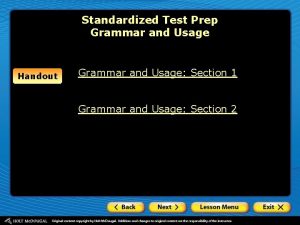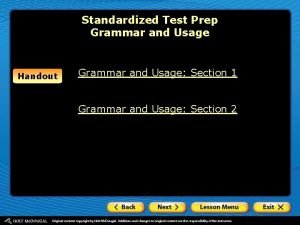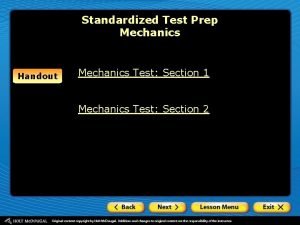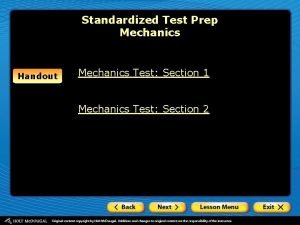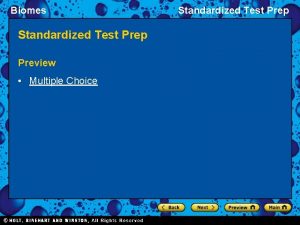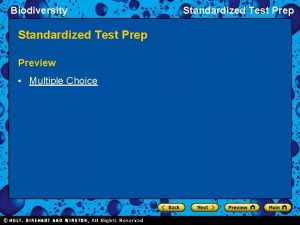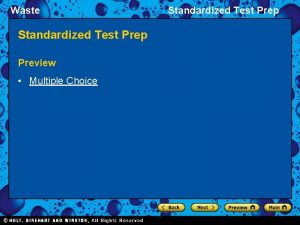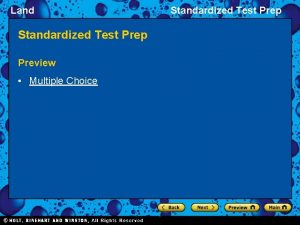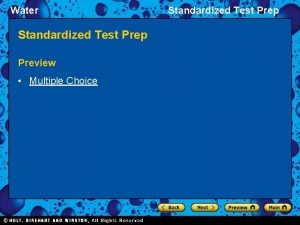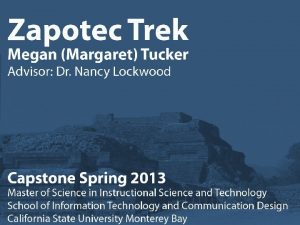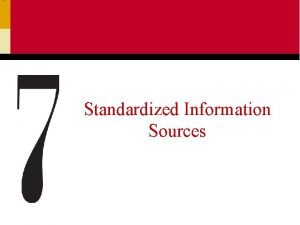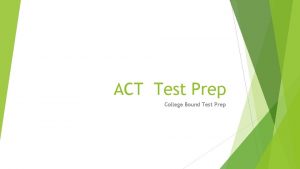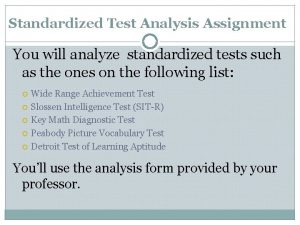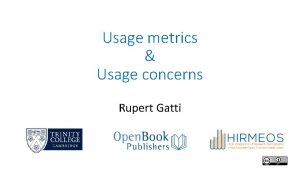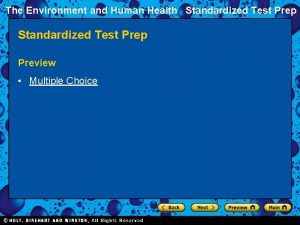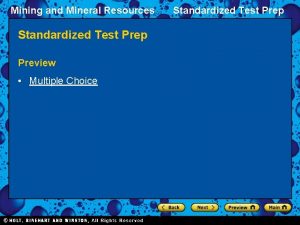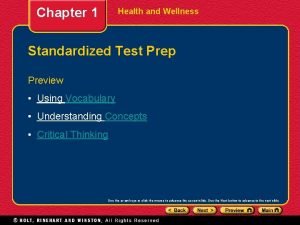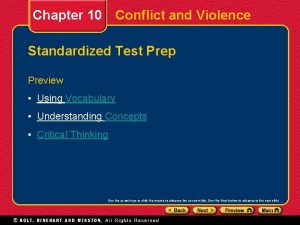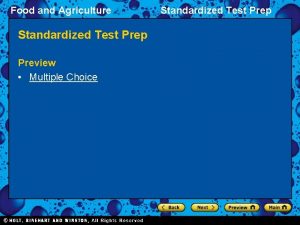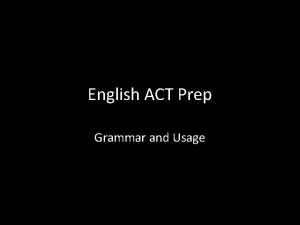Standardized Test Prep Grammar and Usage Handout Grammar































- Slides: 31

Standardized Test Prep Grammar and Usage Handout Grammar and Usage: Section 1 Grammar and Usage: Section 2

Grammar and Usage: Section 1 DIRECTIONS: Read the paragraph below. On the following slides, select the word or word group that best completes the sentence. Scientists __1__ study the prehistoric world __2__ carbon dating to determine the age of organic materials such as wood and bone. All living things absorb carbon-14 from the environment into __3__ tissues. An organism that has died __4__ carbon-14 because __5__ no longer takes in air and food. Carbon-14 that was previously absorbed into the organism’s tissues __6__ at a specific rate. Knowing the rate of breakdown, scientists measure the amount of carbon-14 in an organism’s remains to determine how much time __7__ since the organism died. Scientists cannot use carbon dating to determine the age of organic material __8__ is __9__ about 120, 000 years, because carbon-14 __10__ down and becomes untraceable after that length of time.

Grammar and Usage: Section 1 DIRECTIONS: For each numbered blank, select the word or word group that best completes the sentence. Scientists __1__ study the prehistoric world __2__ carbon dating to determine the age of organic materials such as wood and bone. All living things absorb carbon-14 from the environment into __3__ tissues. An organism that has died __4__ carbon-14 because __5__ no longer takes in air and food. 1. (A) which (B) who (C) whom (D) what 2. (A) they use (B) use (C) uses (D) used

Grammar and Usage: Section 1 DIRECTIONS: For each numbered blank, select the word or word group that best completes the sentence. Scientists __1__ study the prehistoric world __2__ carbon dating to determine the age of organic materials such as wood and bone. All living things absorb carbon-14 from the environment into __3__ tissues. An organism that has died __4__ carbon-14 because __5__ no longer takes in air and food. 3. (A) its (B) his or her (C) they’re (D) their

Grammar and Usage: Section 1 DIRECTIONS: For each numbered blank, select the word or word group that best completes the sentence. Scientists __1__ study the prehistoric world __2__ carbon dating to determine the age of organic materials such as wood and bone. All living things absorb carbon-14 from the environment into __3__ tissues. An organism that has died __4__ carbon-14 because __5__ no longer takes in air and food. 4. (A) doesn’t absorb no more (B) don’t absorb more (C) doesn’t absorb any more (D) don’t absorb any more

Grammar and Usage: Section 1 DIRECTIONS: For each numbered blank, select the word or word group that best completes the sentence. Scientists __1__ study the prehistoric world __2__ carbon dating to determine the age of organic materials such as wood and bone. All living things absorb carbon-14 from the environment into __3__ tissues. And organism that has died __4_ carbon-14 because __5__ no longer takes in air and food. 5. (A) he (B) she (C) it (D) they

Grammar and Usage: Section 1 DIRECTIONS: For each numbered blank, select the word or word group that best completes the sentence. Carbon-14 that was previously absorbed into the organism’s tissues __6__ at a specific rate. Knowing the rate of breakdown, scientists measure the amount of carbon-14 in an organism’s remains to determine how much time __7__ since the organism died. 6. (A) it decays (B) decays (C) decay (D) were decaying 7. (A) passes (B) is passing (C) have passed (D) has passed

Grammar and Usage: Section 1 DIRECTIONS: For each numbered blank, select the word or word group that best completes the sentence. Scientists cannot use carbon dating to determine the age of organic material __8__ is __9__ about 120, 000 years, because carbon-14 __10__ down and becomes untraceable after that length of time. 8. (A) that (B) what (C) who (D) whom 9. (A) more old then (B) older than (C) older then (D) more older than

Grammar and Usage: Section 1 DIRECTIONS: For each numbered blank, select the word or word group that best completes the sentence. Scientists cannot use carbon dating 10. (A) busts (B) busted to determine the age of organic material __8__ is __9__ about (C) break 120, 000 years, because carbon-14 (D) breaks __10__ down and becomes untraceable after that length of time. View All Answers

Grammar and Usage: Section 2 DIRECTIONS: Using the rules of formal, standard English, choose the revision that most clearly expresses the meaning of the underlined part of each item. If there is no error, choose A. EXAMPLE 1. The first Cuban-born woman to become a U. S. Army officer was Mercedes O. Cubria, whom served in the Women’s Army Corps. (A) whom (B) who (C) that (D) which

Grammar and Usage: Section 2 DIRECTIONS: Using the rules of formal, standard English, choose the revision that most clearly expresses the meaning of the underlined part of each item. If there is no error, choose A. 1. In basketball, one kind of illegal dribbling is when a player stops dribbling and then begins dribbling again. (A) is when (B) is that (C) is because (D) occurs when

Grammar and Usage: Section 2 1. In basketball, one kind of illegal dribbling is when a player stops dribbling and then begins dribbling again. (A) is when (B) is that (C) is because (D) occurs when

Grammar and Usage: Section 2 DIRECTIONS: Using the rules of formal, standard English, choose the revision that most clearly expresses the meaning of the underlined part of each item. If there is no error, choose A. 2. Karen’s sandwich is more tastier than the one I brought. (A) more tastier than (B) more tastier then (C) tastier than (D) tastier then

Grammar and Usage: Section 2 2. Karen’s sandwich is more tastier than the one I brought. (A) more tastier than (B) more tastier then (C) tastier than (D) tastier then

Grammar and Usage: Section 2 DIRECTIONS: Using the rules of formal, standard English, choose the revision that most clearly expresses the meaning of the underlined part of each item. If there is no error, choose A. 3. Tonya said she had seen a hummingbird at her feeder in the mall today. (A) Tonya said she had seen a hummingbird at her feeder in the mall today. (B) In the mall today, Tonya said she had seen a hummingbird at her feeder. (C) Tonya said in the mall today she had seen a hummingbird at her feeder. (D) Tonya said in the mall today at her feeder she had seen a hummingbird.

Grammar and Usage: Section 2 3. Tonya said she had seen a hummingbird at her feeder in the mall today. (A) Tonya said she had seen a hummingbird at her feeder in the mall today. (B) In the mall today, Tonya said she had seen a hummingbird at her feeder. (C) Tonya said in the mall today she had seen a hummingbird at her feeder. (D) Tonya said in the mall today at her feeder she had seen a hummingbird.

Grammar and Usage: Section 2 DIRECTIONS: Using the rules of formal, standard English, choose the revision that most clearly expresses the meaning of the underlined part of each item. If there is no error, choose A. 4. Have the Glee Club and they set down to discuss the program? (A) Have the Glee Club and they set (B) Have the Glee Club and them sat (C) Have the Glee Club and they sat (D) Has the Glee Club and they sat

Grammar and Usage: Section 2 4. Have the Glee Club and they set down to discuss the program? (A) Have the Glee Club and they set (B) Have the Glee Club and them sat (C) Have the Glee Club and they sat (D) Has the Glee Club and they sat

Grammar and Usage: Section 2 DIRECTIONS: Using the rules of formal, standard English, choose the revision that most clearly expresses the meaning of the underlined part of each item. If there is no error, choose A. 5. For many years, Matthew Henson accompanied Robert Peary on expeditions, together, in 1908, they set out for the North Pole. (A) expeditions, together, in 1908, they set (B) expeditions, together, in 1908, they setted (C) expeditions; together, in 1908, they setted (D) expeditions. Together, in 1908, they set

Grammar and Usage: Section 2 5. For many years, Matthew Henson accompanied Robert Peary on expeditions, together, in 1908, they set out for the North Pole. (A) expeditions, together, in 1908, they set (B) (C) (D) expeditions, together, in 1908, they setted expeditions; together, in 1908, they setted expeditions. Together, in 1908, they set

Grammar and Usage: Section 2 DIRECTIONS: Using the rules of formal, standard English, choose the revision that most clearly expresses the meaning of the underlined part of each item. If there is no error, choose A. 6. The reason you should wear a helmet is because it can prevent head injuries. (A) is because it (B) is that it (C) is that they (D) is when it

Grammar and Usage: Section 2 6. The reason you should wear a helmet is because it can prevent head injuries. (A) is because it (B) is that it (C) is that they (D) is when it

Grammar and Usage: Section 2 DIRECTIONS: Using the rules of formal, standard English, choose the revision that most clearly expresses the meaning of the underlined part of each item. If there is no error, choose A. 7. A dedicated and creative teacher, Anne Sullivan learned Helen Keller how to communicate effectively. (A) learned (B) taught (C) was learning (D) teached

Grammar and Usage: Section 2 7. A dedicated and creative teacher, Anne Sullivan learned Helen Keller how to communicate effectively. (A) learned (B) taught (C) was learning (D) teached

Grammar and Usage: Section 2 DIRECTIONS: Using the rules of formal, standard English, choose the revision that most clearly expresses the meaning of the underlined part of each item. If there is no error, choose A. 8. Between Josh and him lay the exhausted puppy. (A) him lay (B) he lay (C) him laid (D) him has laid

Grammar and Usage: Section 2 8. Between Josh and him lay the exhausted puppy. (A) him lay (B) he lay (C) him laid (D) him has laid

Grammar and Usage: Section 2 DIRECTIONS: Using the rules of formal, standard English, choose the revision that most clearly expresses the meaning of the underlined part of each item. If there is no error, choose A. 9. The treasure that was buried in the abandoned mine. (A) The treasure that was buried in the abandoned mine. (B) The treasure found buried in the abandoned mine. (C) The treasure buried in the abandoned mine. (D) The treasure was buried in the abandoned mine.

Grammar and Usage: Section 2 9. The treasure that was buried in the abandoned mine. (A) The treasure that was buried in the abandoned mine. (B) The treasure found buried in the abandoned mine. (C) The treasure buried in the abandoned mine. (D) The treasure was buried in in the abandoned mine.

Grammar and Usage: Section 2 DIRECTIONS: Using the rules of formal, standard English, choose the revision that most clearly expresses the meaning of the underlined part of each item. If there is no error, choose A. 10. Peering behind the bookcase, a secret passage was discovered by the detective. (A) Peering behind the bookcase, a secret passage was discovered by the detective. (B) Peering behind the bookcase, the detective discovered a secret passage. (C) The detective discovered a secret passage peering behind the bookcase. (D) While peering behind the bookcase, a secret passage was discovered by the detective.

Grammar and Usage: Section 2 10. Peering behind the bookcase, a secret passage was discovered by the detective. (A) Peering behind the bookcase, a secret passage was discovered by the detective. (B) Peering behind the bookcase, the detective discovered a secret passage. (C) The detective discovered a secret passage peering behind the bookcase. (D) While peering behind the bookcase, a secret passage was discovered by the detective.

The End
 Circuit training standardized test prep answers
Circuit training standardized test prep answers Chapter 13 standardized test practice answers
Chapter 13 standardized test practice answers Chapter 11 standardized test practice
Chapter 11 standardized test practice Practice test chapter 4 ma 08
Practice test chapter 4 ma 08 7-3 standardized test prep
7-3 standardized test prep 6-3 standardized test prep
6-3 standardized test prep 5-1 standardized test prep
5-1 standardized test prep 3-5 standardized test prep
3-5 standardized test prep Aristo grammar and usage (set b answer)
Aristo grammar and usage (set b answer) Unit 3 grammar and usage
Unit 3 grammar and usage Unit 3 grammar and usage
Unit 3 grammar and usage Unit 3 grammar and usage
Unit 3 grammar and usage Tes standar dan tes buatan guru
Tes standar dan tes buatan guru A rock climber's shoe loosens a rock and her climbing buddy
A rock climber's shoe loosens a rock and her climbing buddy Test prep preview
Test prep preview Chapter 14 standardized test practice answers
Chapter 14 standardized test practice answers Chapter 2 chapter assessment
Chapter 2 chapter assessment Chapter 19 standardized test practice answers
Chapter 19 standardized test practice answers Define standardized test
Define standardized test A rock climber's shoe loosens a rock and her climbing buddy
A rock climber's shoe loosens a rock and her climbing buddy Characteristics of standardized test
Characteristics of standardized test Non standard test
Non standard test 6 standardized test practice
6 standardized test practice Scatter plots and data student handout 4
Scatter plots and data student handout 4 Test prep preview
Test prep preview Sat 10 practice test kindergarten
Sat 10 practice test kindergarten Test prep preview
Test prep preview Test prep preview
Test prep preview Test prep preview
Test prep preview What do tokens do in usatestprep
What do tokens do in usatestprep Nocti test answers
Nocti test answers Test prep preview
Test prep preview
